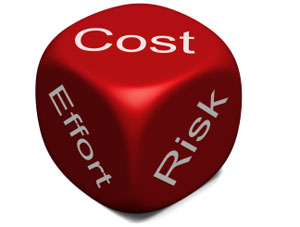Best-in-class companies, BGC says, set up regular SRM reviews that follow a standard format and offer clear escalation procedures when potential problems are flagged. The authors make the strong point that SRM cannot be only the province of the procurement group – the trade-offs and level of risk tolerance must be approached cross-functionally.
 Segment Suppliers Based on Relative Risk: No company can manage detailed risk assessment and mitigation strategies across thousands or even hundreds of suppliers. So, procurement organizations must pick the most important suppliers to focus on, but too often this is done by “gut feel” rather than a formal categorization process. Segment Suppliers Based on Relative Risk: No company can manage detailed risk assessment and mitigation strategies across thousands or even hundreds of suppliers. So, procurement organizations must pick the most important suppliers to focus on, but too often this is done by “gut feel” rather than a formal categorization process.
“Best-in-class companies take a more formal approach, dividing suppliers into different risk categories based on predetermined criteria such as financial health, supply of critical components, supplier value-add, supplier power, time to switch and industry outlook,” BGC says. “These risk assessments are refreshed at least annually, and, in some instances, every quarter. High-risk suppliers are reviewed more often, so that issues are identified early and quick action can be taken.”
Not surprisingly, the authors say, more frequent risk assessment is linked to more successful risk identification.
Rigorously Measure and Manage Risk: Even though it has become well understood that companies need to assess both the probability of a supply disruption and the level of financial impact the disruption might cause, BGC’s research found only 40% of respondents were satisfied that their companies could effectively quantify the likelihood and impact of key risks.
BGC says companies need to add more “rigor” to the risk assessment process, and do a better job collecting cross-functional data that might help identify an emerging supplier problem earlier (for example, are key personnel leaving the supplier?).
Collaborate with Key Suppliers: Complex, global supply chains require higher levels of collaboration. So do very “lean” supply chains (and who doesn’t have one of those these days?), where disruptions can quickly lead to operational and financial problems.
The key point: “Companies such as these must understand the risks of the entire supply chain, not just of individual suppliers. Yet few can single-handedly take on the substantial cost of managing risk across the board. Collaboration is critical,” the BGC consultants say.
The research found few companies say that their companies actively collaborate with suppliers to manage risk.
Give Category Managers Tools and Training: As with many things, most companies agree that supplier risk management is essential, yet the survey showed few companies effectively educate their senior leaders and category managers on how to do it well.
The research showed two-thirds of respondents reported that their companies failed to provide even one full day of risk management training, and most expressed dissatisfaction with current programs company training programs on the subject.
Technology support tools are equally lacking, though BGC says a few companies have complex tools that can track the potential impact of a single event in one location — such as a tornado in Kansas — on all aspects of the supply chain.
“SRM is challenging and requires a proactive, customized approach to get it right,” the BGC authors conclude. “Understanding your company's model, based on your source of competitive advantage and degree of supply chain complexity, reveals critical best practices. These, combined with the five levers for success, can help your company stay ahead of potential supplier problems.”
How well do you think companies manage supplier risk today? Do we need to give procurement managers more training? What would you add or change to the list of key success factors? Let us know your thoughts at the Feedback button below.
|